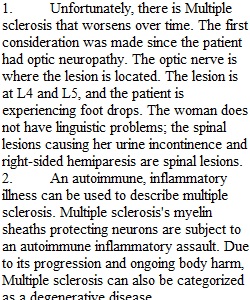


Q Assignment: Neuro Case Study Assignment Instructions Purpose: To examine neurological disease through a case study. To prepare for this assignment, you should: 1. Read Chapter 25 2. Read additional lesson readings in the course content folder. To complete this assignment: 1. Read each mini-case study below. Case 1 A 65 year old hypertensive man suddenly develops severe and profound weakness in his left arm and left leg and severe slurring of speech. He exhibits no language, memory, sensory, or visual disturbances. He is admitted to the hospital under suspicion of a cerebrovascular event. On neurological examination 12 hours later, the only findings are weakness involving the left side of his face and a left hemiplegia. Case 2 A 32 year-old female from Fargo, North Dakota has a history of right optic neuropathy seven years ago with complete recovery of function without any treatment. Four years ago she experienced a left foot drop which improved after treatment by a chiropractor. One month ago she developed urinary incontinence and right-sided hemiparesis without speech or language impairment. Her family physician suspects multiple sclerosis and refers her to a neurologist. 2. Choose ONE of the case studies and respond to the following questions in 2-3 sentences each. a. Localize where in the body this lesion or abnormality is likely occurring. b. Identify two possible disease classifications you feel could be applicable to this case. Discuss why you chose those classifications (based on congenital/hereditary, inflammatory, degenerative, metabolic, or neoplastic). c. Explain two pathological processes that are likely occurring in this case based on: i. Body structures/organs involved ii. Tissues involved iii. Inflammatory or immune responses that could be occurring HLT 410 – Neuro Case Study Assignment d. Identify diagnostic tests or studies that may be used for definitive diagnosis. e. Explain any predisposing factors that may have contributed to this occurrence. f. Characterize possible short-term and long-term functional implications for this patient. g. Describe your professional role if you were involved in an aspect of care for this patient. Submission Instructions ? Save your file as a Word or PDF document (.docx or .pdf). ? Include the term Neuro and your Last Name when saving your file. Example: Neuro_Garcia.docx ? Upload your completed document using the Browse button, and then click the Submit button.
View Related Questions